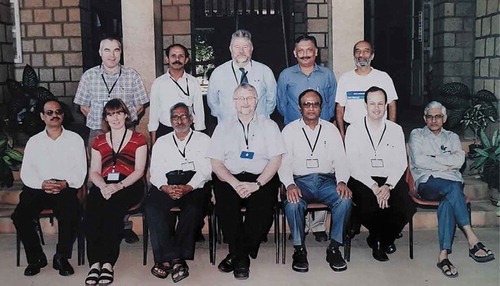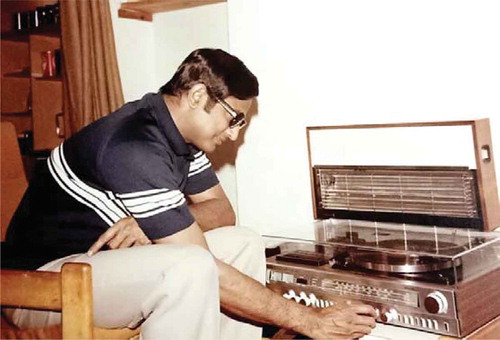Bookinkere Kapanipathaiya Sadashiva, known to most of us as B.K. Sadashiva or BKS, breathed his last on 30 September 2020, at the age of 74, leaving behind his wife Gayathri, son Rajneesh and daughter Namratha.
After his Masters degree in organic chemistry from Bangalore University, BKS took up a research fellowship at the Indian Institute of Science, Bangalore, to work under Prof. G.S.R. Subba Rao. Moving to Raman Research Institute (RRI) in 1973, he did his Ph. D. under the guidance of Prof. S. Chandrasekhar, FRS, the doyen of liquid crystals research in India. The masterful/pioneering character of much of BKS’ work as a synthetic chemist was already evident from the landmark paper on the first observation of discotic liquid crystals (cited over 1000 times, arguably one of the highest citations in the field); BKS, still a doctoral student, was a co-author in the report, along with Chandrasekhar and K.A. Suresh. Another notable contribution that happened around this time was the synthesis of a series of cyano cinnamates and biphenyl benzoates that led to the first report on the re-entrant nematic phase at atmospheric pressure in single component systems. A few years later, one of us (SKP) had the opportunity to work on some of these compounds to explore various aspects of the re-entrant phenomenon, a hot topic of the day. Perhaps, these early achievements also motivated BKS to choose liquid crystals research as his career and to accept the position as a scientist at RRI. Shortly after that, he went to the University College at Cardiff as a Postdoctoral Fellow to work on porphyrins with Prof. A.H Jackson. Returning to RRI, Sadashiva focussed on two topics, metallomesogens and chiral-layered liquid crystals. The former led to the first example of paramagnetic nematic liquid crystals, followed by a significant number of compounds representing s-, p- and d-block elements. In chiral-layered systems, his group synthesised novel compounds exhibiting ferro-, ferri-, and antiferroelectric structures, as well as twist grain boundary phases. The last of these showed an exotic structure, which was labelled by the RRI researchers as undulated twist grain boundary phase exhibiting a three-dimensional photonic bandgap feature. When bent-core liquid crystals caught the attention of liquid crystal community, BKS’ group also entered the arena and made notable contributions. Guiding a number of doctoral students, BKS authored more than 130 much-cited publications and a book chapter in the Wiley-published Handbook of Liquid Crystals, considered as a standard textbook series in the field.
BKS spent his entire professional career at the RRI, remaining a senior professor for several years before retiring in 2008, although he continued to be associated with the institute as INSA Senior Scientist. His contributions in the field have gained worldwide recognition. He received the Materials Research Society of India medal and was the first recipient of the Professor JS Dave Memorial Award by the MS University of Baroda, apart from being the Fellow of National Academy of Sciences. The British Liquid Crystal Society conferred on him its prestigious GW Gray Medal. Liquid Crystals, the premier journal serving the LC community, also had him on its Editorial Board.
The speakers’ photograph at the three day seminar on the ‘Recent Trends in Liquid Crystal Research’, 14–16 November 2005 organised by Prof. Sadashiva at RRI, Bangalore, India. The seminar, first in the series of India–United Kingdom Science Networks programme, was supported by the Department of Science & Technology (DST) New Delhi and The Royal Society, London.
Standing (L to R): Dr A N Cammidge, Dr S Krishna Prasad, Prof D W Bruce, Dr Suresh Das, Prof S Ramaswamy. Sitting: Prof S Kumar, Prof H F Gleeson, Prof V G K M Pisipati, Prof J W Goodby, Prof B K Sadashiva, Prof C T Imrie and Prof N V Madhusudana

One of us (SKP), during his long association with BKS, found him to be generally reserved. Exceptionally, as SKP remembers, on two specific occasions BKS did come out of the shell. The first was during the UK visit by a five-member Indian team – Prof. Sadashiva, Prof. Madhusudana, Dr Pratibha, Prof. Sastry and SKP – in September 2006. His many-sided personality, mentioned below, revealed itself during this visit, especially while staying at Chatsworth Estate, Wetton, with Prof. Helen Gleeson as the host. In fact, this was a reciprocal visit to the previous year’s meet at RRI that BKS organised. The next occasion was the 2007 Ferroelectric Liquid Crystals Conference at Sapporo. Here the bonding happened due to our common predicament as strict vegetarians. His advice on the choice of foodstuffs kept SKP afloat. The camaraderie during all these interactions gave a clear indication of the person he was, his concerns and amiable nature.
While maintaining his deep interest in LCs, Sadashiva pursued his passion in cricket, a game that is almost a religion in the subcontinent. His interest in sports started much earlier, of course. Being the athletics champion at the Central College, where did his Masters, he got the much sought-after ‘Sportsman of the Year’ award. But cricket was his passion. An all-rounder with skills in pace bowling and batting, he was the skipper of the university team and then went on to play for his state team. A few years down the crease, he realised that it was umpiring that he loved most, and took to it with zeal.
Apart from the excellence achieved as an official for ODI and Test matches at the international level, he even coached umpires for many years under the aegis of BCCI! Being a participant in inter-collegiate drama competitions, a Navy cadet of the National Cadet Corps representing the State at the Republic Day parade in New Delhi (a coveted honour for a young lad), a connoisseur of Carnatic music and, above all, an outstanding scientist, BKS was indeed a man of many parts. True to his passion for cricket, he was above board in all his dealings and would always bat straight. With his demise, the LC community has not only lost an excellent chemist, but a fine gentleman in the true spirit of the word.
We express our deepest appreciation to the family of Prof. Sadashiva, especially his son, and younger brother, Mr B. K. Chandrasekhar, for providing invaluable information about BKS’s personal life.
Sandeep Kumar
Raman Research Institute, Bangalore, India


